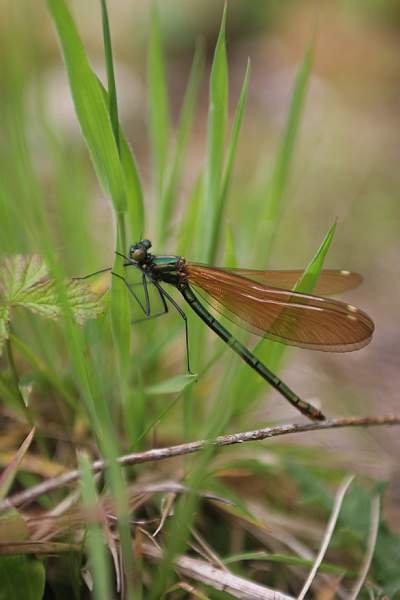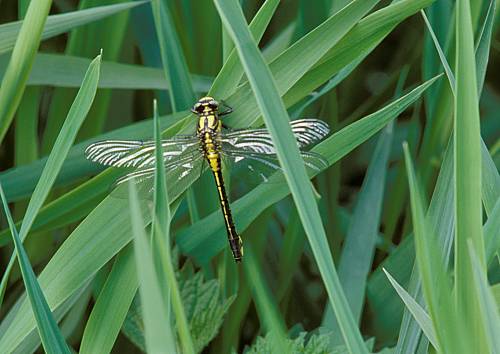|
||||||||||||||||||||||||||||||||||||||||||||||||||||||||||||||||||||||||||||||||||||||||||||||||||||||||||||||||||||||||||||||||||||||||||||||||||
Warwickshire Dragonfly Group - News page
Table of Earliest Dates for 2009 October 22nd
2009 Black Darters in the county September 26th 2009 Grendon Common
field meeting July 26th 2009
Whitehall Farm field meeting July 11th
2009
Keeled Skimmer and Red-veined Darter June 7th 2009 New Hairy Dragonfly sites May 23rd 2009 Alvecote field meeting May 21st
2009
More dragonflies flying May 8th
2009
Beautiful Demoiselle and Hairy Dragonfly flying May 4th
2009
Club-tailed Dragonfly and Banded Deomoiselle flying April 24th
2009
More flight reports and Atlas maps update April 19th 2009
First Adults of 2009 April 4th 2009
Larvae Identification Workshop, Brandon Marsh A new record for late flying dragonflies in the county. Jon Bowley emailed the following: "I have just returned from visiting Salford Priors (this is December 6th!) where I was amazed to find a male Common Darter sunning itself Perhaps we should not assume the the flying season ends in early November and get out on warm sunny days all through to late(?) December! The following paragraph, which the author thought was the last word on late fliers this year is out of date. Below are the latest dates for species flying between September and November. There are only two November records, both for Common Darter, and the last one is quite late for species in the county. The only two later records are for the year 2006 which had a particularly mild and long drawn out autumn, see the 2006 table. If you have any records for late flying or, indeed, any dragonflies or damselflies please send them them in.
Back to page top. Table of Earliest Dates Recorded The table shows the earliest dates adults have been observed this year in Warwickshire. The Club-tailed Dragonfly emergence date is the earliest ever recorded in the county by six days and that for the Beautiful Demoiselle five days.
If you have any earlier dates for 2009 or earlier years please let me have them. Back to page top. Black Darters in the county Several Black Darters have been seen at Marsh Lane Reserve, Hampton in Arden on a number occasions between 11 September and 12 October and by different observers, Lee Johnson, Graham Rowling and Kay & Peter Reeve. On occasions there were more than one individual. It is unusual to see Black Darter in Warwickshire at all. For there to be several sightings at the same site over a number of weeks is very unusual. Corbet & Brooks in "Dragonflies" report a study that found more than 50% left a water body within two hours of their arrival. It could suggest either an exceptional fidelity of individuals to a far from optimal site for breeding or that a significant movement of Black Darter into the county this year. Back to page top. Grendon Common field meeting, 26 September 2009 As advertised, this was field meeting with a different emphasis: to look for both late flying dragonflies and grasshoppers and crickets on the site. Grendon Common is an old pit head that has areas of heather, a habitat rare in Warwickshire. A dozen local Group members attended and we set off in cloudy but warm conditions. Almost immediately a Migrant Hawker was seen flying ahead. It did not stay long but disappeared over the adjoining woodland. Dragonflies were few and far between on the day. The only others we saw were a few Common Darters and single male Southern Hawker holding territory on one of the pools. 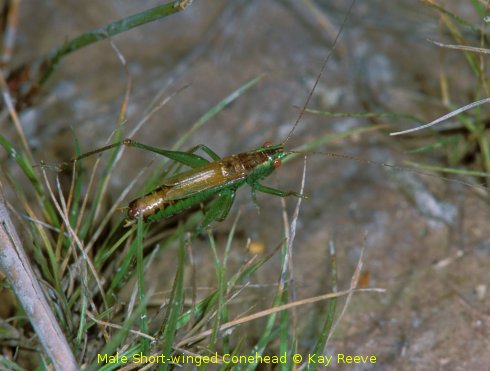 Grasshopper
and Cricket species were greater in numbers and species.
Meadow, Field and Lesser Marsh Grasshoppers were about in reasonable
numbers. A species confined to only a few sites in Warwickshire, the
Mottled Grasshopper, was found on the open heathy area. However, we
only saw females. The sight of a male eluded us though their
attractive and distinctive calls could be heard. Grasshopper
and Cricket species were greater in numbers and species.
Meadow, Field and Lesser Marsh Grasshoppers were about in reasonable
numbers. A species confined to only a few sites in Warwickshire, the
Mottled Grasshopper, was found on the open heathy area. However, we
only saw females. The sight of a male eluded us though their
attractive and distinctive calls could be heard.The hunt for crickets was much helped by the use of ultrasound detectors. Males of Long-winged Conehead and Roesel's Bush Cricket were singing in good numbers though elusive. Females were more obvious to the eye. The best sighting of the day was of the rarer Short-winged Conehead. Calling males were detected here in 2008 but not seen. This year they were seen, heard and photographed. In the afternoon we visited another old colliery site close by, Baddesley Common. Much the same species were seen (and heard) there. Some of our number with expertise in other groups (shieldbugs, ladybirds, moths, butterflies and sawflies) raised our total list of insect species seen for the day to 32. Back to page top. News update, 26 August 2009 The Keeled Skimmer has been seen again by Keith Warmington on the 2nd August at the same site as in July, Baddesley Colliery. The next day Kay and Peter Reeve made a visit and found it too. It was a very mature male and may be the same specimen seen in July. If so, it shows high fidelity to the site. As the table of earliest flights shows, all our species have been flying for some time now. This year Small Red-eyed Damselfly has been found at several sites it was at in previous years. However, they seem to be in lower numbers this year. Also, they are yet to be found at some established sites. Only one new site, with a few specimens, has been found this year at Chalecote. If you have any Small Red-eye sightings please send in the record. Migrant Hawker should now be at its most prolific. So far, they have only been reported in ones and twos and no breeding activity has been reported. Again, records of sightings are welcome. While Kay and Peter Reeve were seeking Small Red-eyed Damselflies a few days ago a strange and unusual piece behaviour was observed. A female Banded Demoiselle flew over weed with a number of perched male Common Blue Damselflies. One of the males flew up to the Banded Demoiselle and grasped her in the tandem position. He grimly and optimistically hung while the female flew, perched and flew. When in flight he was thrown about violently by the females actions but still held on and the pair disappeared still in tandem. Back to page top. Whitehall Farm field meeting, 26th July 2009 Ten hopeful odonatists were met by Jim Russell at Whitehall Farm, Toft, Dunchurch on a breezy and cloudy but warm morning. We were taken a tour of the water bodies on the farm. We walked along the wide headland surrounding a large field of cereal which was rich in "weeds". Jim commented that in the 1940s and 50s he would have been taken to court for allowing his farm to get in such a state. Now he wins awards for ecologically friendly farming! Our hearts were lifted by the masses of Painted Ladies, Common Blues and, more specially, by Brown Argus exploiting this habitat.Would the dragonflies be as prolific today? The first pool, a steep sided but well vegetated irrigation pond, was surveyed hopefully but yielded little, only a few Azure and Blue-tailed Damselflies. We moved on to the River Leam, here a small stream which is known to have good populations of Banded and Beautiful Demoiselles and White-legged Damselflies. However, some searching was required to find just a few Banded Demoiselles and a representative White-legged Damselfly. It began to dawn on us that we were going have to work hard to find perhaps fewer species than we hoped for.
Back to page top. Keeled Skimmer and Red-veined Darter
Back to page top. News update, 18th June 2009 As the table of Earliest Dates shows, all the spring and early summer species, except Ruddy Darter, have now been seen and recorded in the county. Most pleasingly, the Scarce Blue-tailed Damselfly was found again by Jonathan Bowley at the only county breeding site for the species. He found two males and two females flying on 14 June. It has been recorded there every year since it was first found in 2002. How long it will remain depends on how the reinstatement and maintenance of the closed quarry is managed. Hairy Dragonflies continue to make their presence felt at Wormleigton and Napton reservoirs. A number of Group members have made visits the reservoirs and found it. On June 14 at about 4pm Kay and Peter Reeve saw two females feeding there at the Wormleighton Resrvoir. However, the end of their flight season is approaching so we may have seen most of the activity for this year. In 2010 an effort will be needed to try and prove breeding at these sites by finding exuvia. In 1997 the Club-tailed Dragonfly was first recorded in Warwickshire on the Avon. Previous to that the nearest known breeding population was at de Montford bridge, Evesham. The next big hope for a new species in Warwickshire is the Scarce Chaser which has been in the de Montford bridge area for a number of years. Kay and Peter Reeve have made several visits to the Avon in the Bidford area hoping to find it, so far without success. In spite of this might it already be in the county? An email recently received from Jonathan Bowley said: "....puzzling
chaser
observed very briefly looked a bit like a male Scarce Chaser (blue body
with
black tip and possibly dark bases to wings), but I only saw it in
flight so I
was probably wrong".
That sounds very interesting. So, get down to the Avon in the next few
weeks and you may be the first to positively record Scarce Chaser in
Warwickshire.Back to page top. New Hairy Dragonfly sites The last few days, before the weather broke, have been very exciting. There is a good chance that Warwickshire has gained two new Hairy Dragonfly breeding sites: Wormleighton Reservoir and Napton Reservoir. Following up on Jonathan Bowley's report of an individual hunting on May 10th at Wormleighton, Kay and Peter Reeve visited the site on 29th May. It turned out to be very productive. Shortly after arriving at 11am a male Hairy Dragonfly was sighted dodging in and out of the marginal reeds looking for females. This was just the start. Two hours later a total of at least six males, with many more individual sightings, were seen. They were all holding territory. One of the males found a female in the reeds, grabbed her and flew off into the trees in the mating position. Almost certainly the female had been ovipositing. A second copulating pair was disturbed and flew up into the trees. The species was also evident on visits by Lloyd Patton on 31st May and Jill Roberts on1st June. It is probable that Hairy Dragonflies are breeding at Wormleighton. They are certainly showing breeding behaviour though proof of breeding will have to await the finding of exuvia. It is probably too late to find one this year. As if this was not enough, Kay and Peter visited Napton Reservoir on 31st May and found Hairy Dragonfly there - the first record for the site. There were two males on the pools by the car park and another in the NW corner of the reservoir. They were searching the reeds round the edge looking for females. They did not appear to find any. There were at least three males there, all holding territory/female searching. As with Wormleighton, this raises the possibility of them breeding at Napton too. Observation of copulation or oviposition would be a more certain indicator of breeding or, at least, its initiation. The final proof will have to wait for an exuvia find. It is a bit late in the season to expect that this year. Back to page top. Alvecote field meeting, 23rd May 2009 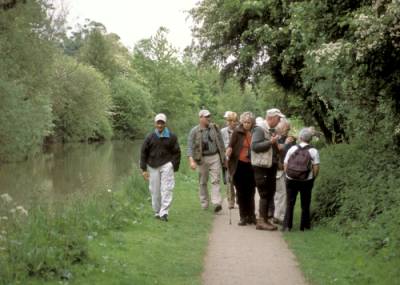 Eighteen WDG and BDS members met in the Pooley County
Park car park on
a bright , breezy day with sunny periods. The prospects were good for
finding
the prime target species: the Hairy Dragonfly. Eighteen WDG and BDS members met in the Pooley County
Park car park on
a bright , breezy day with sunny periods. The prospects were good for
finding
the prime target species: the Hairy Dragonfly.We moved off towards the Alvecote Pools reserve and soon found out first dragonflies of the day where the path crosses the Coventry Canal. The main attraction was a Four-spotted Chaser supported by a few Blue-tailed Damselflies and a Banded Demoiselle. Further along the path was a Broad-bodied Chaser still brightly coloured and immature which provided a subject for the photographers. At the first pool, with a relatively small area of open water and surrounded by extensive reed beds, we saw our first Hairy Dragonflies. There were two males holding territory and searching for females among the reeds. A second pool yielded two more males holding territory and third male was disturbed from a perch near by and briefly observed by a few members of the group before it flew into the the trees. Those holding territory were flying some way from dry land on the outer edge of reed beds not giving good close views. However, the sightings were a good augury for what might be on the large Canal Pool where, on a good day, several males can be found holding territory. Here it is possible to get much closer to them than on most of the site. It was not to be so. There was no sign of Hairy Dragonflies on the pool at all. Quite why, when they were present on other pools, is not clear. May be a recent significant flooding event on the reserve, the flood marks of which were visible well up the trunks of trees in the surrounding woodland, introduced pollution. It is possible. The site is a reclaimed pit head and there is a badly polluted pool near by. Azure and Blue-tailed Damselflies were widely present in small numbers, however, in a couple of sheltered spots there were large concentrations of these species feeding. There were also a few immature Red-eyed Damselflies with them. Our haul of eight species for the day is completed by Large Red Damselfly which was present in small numbers. The picture shows some of the group returning along the tow path of the Coventry Canal hoping to get the ninth species of the day, White-legged Damselfly, but without success. We debriefed with a welcome cup of tea at the County Park cafe and concluded the day was successful, we did find our target, but with some concern about the absence of Hairy Dragonfly on Canal pool. Back to page top. May 21st 2009 Twelve species are now emerged and flying in Warwickshire. As the flight tables shows, the first records for some species are significantly later than the earliest recorded flights. But three species, Club-tailed Dragonfly, Beautiful Demoiselle and Four-spotted Chaser recorded their earliest flight times, the last by just one day. Adam Archer saw a single Hairy Dragonfly at Alvecote Pools on 10th May. Is this an auspicious sign for the meeting on Saturday 23 May? Jonathan Bowley reported a very interesting sighting of a Hairy Dragonfly hunting at Wormleighton Reservoir on 10th May. In 2007 Jonathan spotted a Hairy fairly close by at Fenny Compton. Could we be about to find our third Warwickshire breeding site for this species? Kay and Peter Reeve visited Wormleighton Reservoir on 19th May hoping to find the Hairy Dragonfly but without success. However, there was a very large number of newly emerged Azure Damselfly, Blue-tailed Damselfly and Red-eyed Damselfly. There were also a few White-legged Damselfly. Back to page top. May 8th 2009
Back to page top. May 4th 2009
Back to page top. April 24th 2009 Jim Timms reported more Large Red Damselflies at Bubbenhall and Steven Falk a single Large Red at Hillmorton on 22nd April. On 23rd April Keith Warmington saw Large Reds at Stockton and Ryton and Jonathan Bowley a single at Weston Wood. The Atlas maps have been updated with these records. You will also find the Larvae workshop records mapped (not surprisingly for larvae!) and for larvae found at Marton on 22nd April. The only flying dragonflies seen this year so far are the Large Reds. Back to page top. The first report of flying odonates was received today. Jim Timms
recorded six Large
Red Damselflies at Bubbenhall. Larvae Identification Workshop, Brandon Marsh - 4 April 2009 Once again the ID workshop was very popular and
oversubscribed. It will run again next year and so any that were
disappointed will be able to come next year - if they book early enough. There were the usual indoor and an outdoor sessions. The
sessions were especially exciting this year. Steve Cham allowed us to
make use of a draft copy of his about to be published "Field Guide to
larvae and exuvia of British Dragonflies" Vol2. Damselflies. This book
is is absolutely excellent and proved invaluable. It has really
marvellous photographs showing the diagnostic features. With it we were
able to successfully separate two of the difficult species, Azure
Damselfly and Common Blue-tail with comparative ease. It will be
available from the BDS within a month or two and likely to be very
competitively priced at less than £10. In the afternoon
we found and identified larvae of Large
Red Damselfly, Red-eyed Damselfly, Azure Damselfly, Common Blue-tailed
Damselfly and Southern Hawker. We also had a magnificent Water Stick
Insect. Thanks are due to Caroline Bailey for her great help and Warwickshire
Wildlife Trust for providing the facilities. Please send any item for inclusion on the news page to: Peter Reeve, Co-ordinator WDG
|
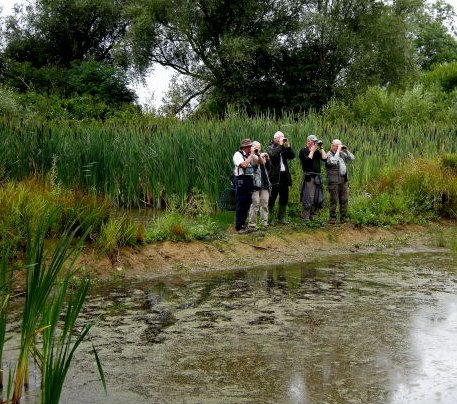 An area developed by Jim
since the last WDG visit to Whitehall in 2004
was our next venue. It is wet grassland of about 20 acres with a
large
scrape to attract waders. Part holds water all year. We
approached it
over dry and not so dry mud trying to minimise the disturbance of the
Little Ringed Plover family that bred there. Our reward was to find a
few resident male Black-tailed Skimmers so typical of this habitat.
An area developed by Jim
since the last WDG visit to Whitehall in 2004
was our next venue. It is wet grassland of about 20 acres with a
large
scrape to attract waders. Part holds water all year. We
approached it
over dry and not so dry mud trying to minimise the disturbance of the
Little Ringed Plover family that bred there. Our reward was to find a
few resident male Black-tailed Skimmers so typical of this habitat.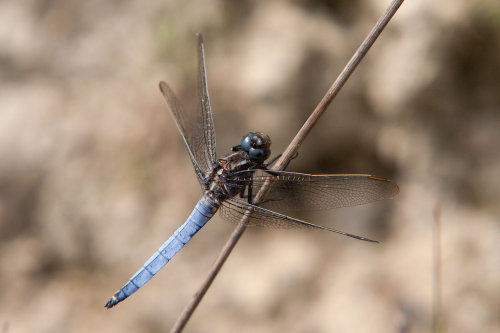 It was still
there four days later when it was seen by Ron Thomas too. It is almost
certainly an unusual vagrant but there are marks on the abdomen that
suggest it has mated.
It was still
there four days later when it was seen by Ron Thomas too. It is almost
certainly an unusual vagrant but there are marks on the abdomen that
suggest it has mated.